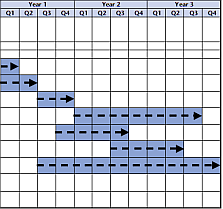Protection Engagement Projects: from Initiation to Execution

Think of your security engagement as planning a big event. What do you need to consider? Things like having the right squad in place from day one, a budget sponsor (typically the CEO, CFO, or COO), a project manager or security lead, the individuals being protected (executives, VIPs, staff), as well as HR, legal, and IT, all need to be on the same page.
In this blog, we talk about the three core phases (Initiation, Planning, and Execution) to keep your costs in check, manage risks, and integrate your security partner seamlessly into daily operations. A RACI checklist will help you get everything in control.
1. Project Initiation: Defining Your Protection Project
A successful security engagement project begins with a clear mandate. In this initiation phase, you’ll assemble your project’s stakeholder team, including these roles:
- A sponsor who controls the budget (CEO, CFO, or COO).
- A project manager to handle day-to-day coordination (office manager or security lead).
- The end-users who require protection include executives, VIPs, and facility occupants.
- HR and legal experts should also be engaged early to vet contracts and personnel, while IT can advise on access-control integrations.
Once the team is assembled and aligned, articulate your objectives in precise, measurable terms. Are you seeking visible deterrence through uniformed patrols provided by security guard companies? Or do you need discreet agents from leading close protection security companies that can anticipate and intercept threats before they materialize?
Define your success criteria up-front, whether that’s zero security incidents over six months, guaranteed alarm response within five minutes, or uninterrupted personal escort for a traveling executive.
With goals in hand, draft a concise charter that captures the “what,” “who,” and “why” of the project. Summarize the scope (for example, “two close-protection officers for all public appearances plus emergency extraction readiness”), establish a ballpark budget (ex.: $200K–$300K annual retainer or $50–$90/hour T&M), and outline major milestones (contract award, onboarding, 30-day performance review). A signed charter cements stakeholder commitment and provides an explicit reference as you progress into detailed planning.
2. Project Planning: Scope Definition, Risk, Budget
At this phase, you want to break down the project charter into actionable components; each defines the related deliverable, logs every potential threat, and establishes a realistic budget. Translate high-level scope into granular requirements:
| Requirement | Close Protection | Security Guards | Notes |
|---|---|---|---|
| Coverage Hours | Continuous 24/7 or as-needed detail | Shift-based (e.g., 8-hr rotations) | Define overlap periods or handoff procedures |
| Risk Assessment | Personalized threat modeling & intel prep | One-time site survey & standard SOPs | Clarify who owns ongoing risk logging |
| Response Protocol | Emergency extraction team & medical evac | Alarm escalation & local police liaison | Specify response time SLAs (e.g., 5 min) |
| Reporting & Documentation | Daily intelligence brief and incident log | Shift handover report and logbook | Agree format, tool (PDF, shared drive, Slack) |
| Integration with PM Tools | Real-time dashboard, Slack channels | Optional spreadsheet or email updates | Decide on a common communication platform |
In parallel with the scope definition, create a risk register. For every identified threat, such as crowd surges at a public appearance, unauthorized vehicle access at a corporate campus, or emergency medical events, assign a probability and impact rating, name a mitigation owner (lead protection agent or site supervisor), and document the countermeasure (advance route reconnaissance, temporary barriers, or medical evacuation plan). Your risk register will guide both your initial RFP and ongoing incident management.
Budgeting is more than plugging in hourly rates. Decide whether a time-and-materials arrangement or fixed-price contract better suits your organization’s appetite for cost predictability versus flexibility. Cap overtime and travel expenses in writing to avoid surprise invoices, and specify payment milestones—perhaps on contract signing, after the onboarding phase, and at your 30- or 90-day performance review.
And finally, do these:
- Weave these elements into a simple schedule and responsibility matrix.
- Map vendor selection, contract negotiation, site survey, SOP development, onboarding drills, and go-live dates on a two- to three-week timeline.
- Clarify who is responsible for each task (your security firm’s on-site supervisor), who is accountable (your operations manager), and who must be consulted or informed, such as HR for background checks or the executive assistant for itinerary changes.
Project Execution: Onboarding and Integration
With your project charter approved and plan in hand, it’s time to bring your chosen security provider on-site and weave them into your daily operations. In execution, preparation meets practice, meaning that it turns paper requirements into real-world security.
First, schedule a joint site survey. Your security lead and the provider’s operations manager should walk every perimeter, lobby, and back corridor, pausing to note camera blind spots, emergency exits, and any ad-hoc risks (delivery entrances, unlit paths). Based on that walk-through, finalize Standard Operating Procedures. These SOPs become your playbook: they guide how guards or protection agents circulate, who they notify in the event of an alarm, and how they document every incident.
Next, equip the team with everything they need, including access badges, radio frequencies, secure messaging channels, parking permits, and visitor-management credentials. Whatever ties them into your infrastructure.
Host an orientation session where you introduce on-site supervisors to key contacts (facility staff, executive assistants, IT administrators). Use this meeting to agree on daily check-in rituals, including a morning briefing that highlights new information, a hand-off huddle at shift change, and an end-of-day report that syncs with your project dashboard.
Finally, test your procedures in controlled drills. Run a mock alarm response to confirm that the team can reach the point within your agreed SLA, that they follow the escalation path you defined in planning, and that their incident reports meet your format requirements. If any gaps emerge (like slower response in a particular zone or unclear hand-off responsibilities), adjust your SOPs and repeat until your security partner operates as seamlessly as an internal department.
Control Your Protection Project with RACI
Getting clear on who does what, even before your first site visit, cuts confusion and keeps your project running smoothly. Consider these ideas to supercharge your RACI:
- Nail down your to-do list
- Brainstorm every milestone and deliverable: charter sign-off, vendor RFP, site survey, SOP review, badge issuance, orientation drill, SLA sign-off
- Don’t stop at big phases—include the little hand-offs (shift huddle, incident report submission, dashboard update)
- Assign R-A-C-I to each item
- Responsible: who actually does the work (security lead, vendor ops manager)
- Accountable: who signs off and owns the outcome (project manager, operations VP)
- Consulted: who provides input or expertise (HR, legal, IT)
- Informed: who needs updates (executive sponsor, assistants, front-line staff)
- Visualize & share your checklist
- Build your RACI in a shared Google spreadsheet or project management tool, such as ClickUp, Trello, or Teamwork (read more)
- Pin it up in every key meeting, stash the links in your team’s Slack, and attach it to your project charter
- Treat it like a living doc
- Review and update at each phase gate or during weekly check-ins with your security vendor. New tasks emerge, roles shift, and tomorrow’s “informed” may become tomorrow’s “responsible.”
- Use your RACI to diagnose bottlenecks (“Why is SOP sign-off dragging?”) and re-align resources on the fly
- Tie it to your risk register & schedule
- Link each high-priority risk mitigation task to its RACI row so you know instantly who’s tracking crowd-control drills or emergency extraction rehearsals
- Embed RACI references in your Gantt or Kanban board; when a due date slides, you see at a glance which role needs assistance













